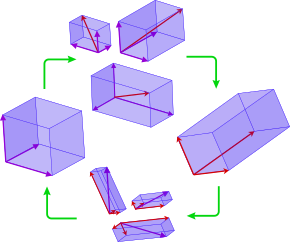This article needs additional citations for verification. (November 2017) |
In mathematics, an ordered basis of a vector space of finite dimension n allows representing uniquely any element of the vector space by a coordinate vector, which is a sequence of n scalars called coordinates. If two different bases are considered, the coordinate vector that represents a vector v on one basis is, in general, different from the coordinate vector that represents v on the other basis. A change of basis consists of converting every assertion expressed in terms of coordinates relative to one basis into an assertion expressed in terms of coordinates relative to the other basis.[1][2][3]
Such a conversion results from the change-of-basis formula which expresses the coordinates relative to one basis in terms of coordinates relative to the other basis. Using matrices, this formula can be written
where "old" and "new" refer respectively to the initially defined basis and the other basis, and are the column vectors of the coordinates of the same vector on the two bases. is the change-of-basis matrix (also called transition matrix), which is the matrix whose columns are the coordinates of the new basis vectors on the old basis.
A change of basis is sometimes called a change of coordinates, although it excludes many coordinate transformations. For applications in physics and specially in mechanics, a change of basis often involves the transformation of an orthonormal basis, understood as a rotation in physical space, thus excluding translations. This article deals mainly with finite-dimensional vector spaces. However, many of the principles are also valid for infinite-dimensional vector spaces.
- ^ Anton (1987, pp. 221–237)
- ^ Beauregard & Fraleigh (1973, pp. 240–243)
- ^ Nering (1970, pp. 50–52)





